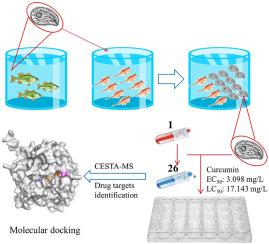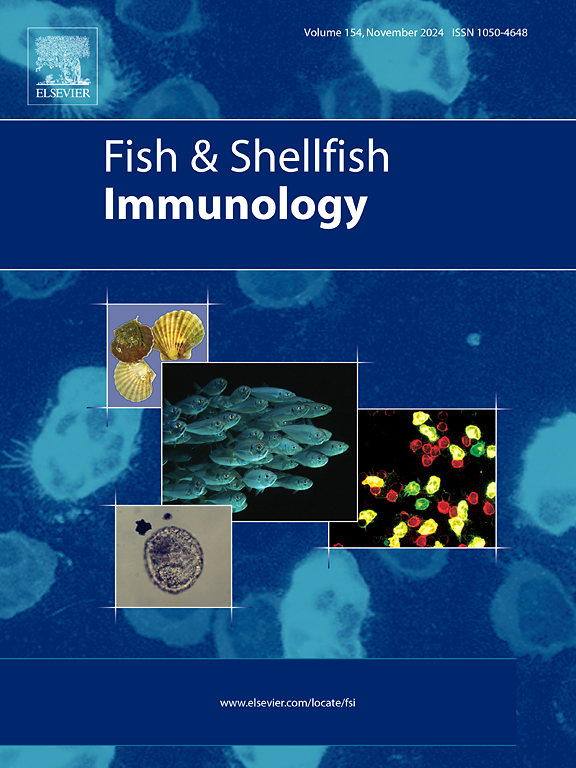Curcumin is an efficacious therapeutic agent against Chilodonella uncinata via interaction with tubulin alpha chain as protein target
IF 4.1
2区 农林科学
Q1 FISHERIES
引用次数: 0
Abstract
Chilodonella, a parasitic ciliate that infects both cold water and warm water fish, can impede the growth of juvenile fish and cause considerable economic losses globally to freshwater aquaculture. In this study, the parasite was collected from both the gills and zygotes of largemouth bass (Micropterus salmoides). Isolated from diseased fish, the parasites were identified as Chilodonella uncinata based on morphological features and genetical diagnostic characterization using the partial small subunit ribosomal RNA gene. To develop an effective approach to treat chilodonellosis caused by C. uncinata in largemouth bass farming, we first developed an in vivo culture model for propagating C. uncinate and thus could use for morphological characterization, molecular analyses and antiparasitic drug screening. Curcumin was successfully identified as an efficacious anti-C. uncinata agent from 26 phytochemical compounds. When administered at a concentration of 6 mg/L, curcumin not only completely cured infected largemouth bass but also shielded uninfected fish from C. uncinata infections. The 24 h median effective concentration (EC50) of curcumin against C. uncinata was 3.098 mg/L. Remarkably, the 96 h median lethal concentration (LC50) of curcumin against largemouth bass was determined to be 17.143 mg/L, approximately 5.533 times higher than EC50. The mechanism of action of curcumin was investigated by the cellular thermal shift assay, demonstrating that tubulin alpha chain was the binding target for curcumin. Moreover, SEM investigations further provided morphological evidence suggesting that curcumin induces parasite demise by disrupting the parasite's body surface and subsequently infiltrating its interior. These findings collectively emphasize the potential of curcumin as a safe and effective therapeutic agent for controlling C. uncinata in aquaculture.

姜黄素通过与作为蛋白质靶点的微管蛋白α链相互作用,是一种有效的奇洛虫治疗剂
纤毛虫(Chilodonella)是一种寄生性纤毛虫,既能感染冷水性鱼类,也能感染暖水性鱼类,它能阻碍幼鱼的生长,给全球淡水养殖业造成巨大的经济损失。在这项研究中,从大口鲈鱼(Micropterus salmoides)的鳃和子代中都采集到了寄生虫。从病鱼身上分离出的寄生虫根据形态特征和部分小亚基核糖体 RNA 基因的遗传学诊断特征被鉴定为 Chilodonella uncinata。为了开发一种有效的方法来治疗大口鲈养殖中由 C. uncinata 引起的奇洛虫病,我们首先开发了一种用于繁殖 C. uncinate 的体内培养模型,从而可用于形态特征、分子分析和抗寄生虫药物筛选。我们成功地从 26 种植物化学成分中鉴定出姜黄素是一种有效的抗 C. uncinata 寄生虫药物。以 6 毫克/升的浓度给药时,姜黄素不仅能完全治愈受感染的大口鲈鱼,还能保护未受感染的鱼免受 C. uncinata 感染。姜黄素对 C. uncinata 的 24 小时中位有效浓度(EC50)为 3.098 毫克/升。值得注意的是,姜黄素对大口鲈鱼的 96 小时中位致死浓度(LC50)为 17.143 毫克/升,约为 EC50 的 5.533 倍。通过细胞热转移试验研究了姜黄素的作用机制,结果表明管蛋白α链是姜黄素的结合靶标。此外,扫描电子显微镜研究进一步提供了形态学证据,表明姜黄素通过破坏寄生虫的体表并随后渗入其内部来诱导寄生虫死亡。这些研究结果共同强调了姜黄素作为一种安全有效的治疗剂,用于控制水产养殖中的 C. uncinata 的潜力。
本文章由计算机程序翻译,如有差异,请以英文原文为准。
求助全文
约1分钟内获得全文
求助全文
来源期刊

Fish & shellfish immunology
农林科学-海洋与淡水生物学
CiteScore
7.50
自引率
19.10%
发文量
750
审稿时长
68 days
期刊介绍:
Fish and Shellfish Immunology rapidly publishes high-quality, peer-refereed contributions in the expanding fields of fish and shellfish immunology. It presents studies on the basic mechanisms of both the specific and non-specific defense systems, the cells, tissues, and humoral factors involved, their dependence on environmental and intrinsic factors, response to pathogens, response to vaccination, and applied studies on the development of specific vaccines for use in the aquaculture industry.
 求助内容:
求助内容: 应助结果提醒方式:
应助结果提醒方式:


